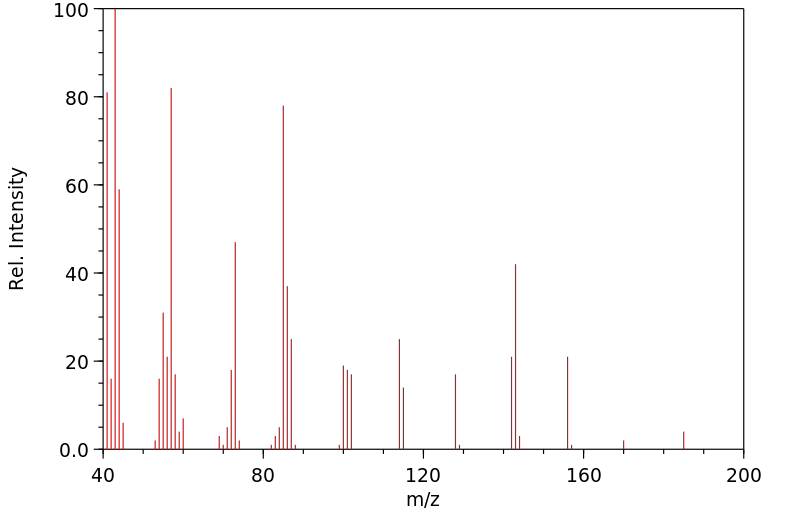N-己基戊酰胺 | 10264-25-2
中文名称
N-己基戊酰胺
中文别名
——
英文名称
N-hexylpentanamide
英文别名
N-Hexyl-valeramid
CAS
10264-25-2
化学式
C11H23NO
mdl
MFCD01761564
分子量
185.31
InChiKey
HYTMILDAGQOHDF-UHFFFAOYSA-N
BEILSTEIN
——
EINECS
——
-
物化性质
-
计算性质
-
ADMET
-
安全信息
-
SDS
-
制备方法与用途
-
上下游信息
-
文献信息
-
表征谱图
-
同类化合物
-
相关功能分类
-
相关结构分类
物化性质
-
沸点:319.55°C (rough estimate)
-
密度:0.9315 (rough estimate)
-
保留指数:1516
计算性质
-
辛醇/水分配系数(LogP):3.2
-
重原子数:13
-
可旋转键数:8
-
环数:0.0
-
sp3杂化的碳原子比例:0.909
-
拓扑面积:29.1
-
氢给体数:1
-
氢受体数:1
SDS
反应信息
-
作为反应物:参考文献:名称:Alferiev, Ivan S.; Bobkov, Sergey Yu., Zeitschrift fur Naturforschung, B: Chemical Sciences, 1992, vol. 47, # 9, p. 1213 - 1224摘要:DOI:
-
作为产物:描述:参考文献:名称:N-酰基-N-(4-氯苯基)-4-硝基苯磺酰胺:用于在水中酰化胺的高选择性和高效试剂摘要:摘要 多种 N-酰基-N-(4-氯苯基)-4-硝基苯磺酰胺 (1a-e) 在无溶剂条件下由 4-氯苯胺在一锅中合成,并已被开发为化学选择性 N-酰化试剂。描述了在仲胺存在下伯胺的选择性保护、芳胺存在下脂肪胺的酰化、伯仲二胺的单官能化以及使用这些试剂的氨基醇的选择性 N-酰化。所有酰化反应均在作为绿色溶剂的水中进行。这些酰化试剂的高稳定性和易于制备是该方法的其他优点。DOI:10.1515/znb-2015-0076
文献信息
-
Manganese-Catalyzed Direct Conversion of Ester to Amide with Liberation of H<sub>2</sub>作者:Akash Mondal、Murugan Subaramanian、Avanashiappan Nandakumar、Ekambaram BalaramanDOI:10.1021/acs.orglett.8b01305日期:2018.6.1A simple and efficient Mn-catalyzed acylation of amines is achieved using both acyl and alkoxy functions of unactivated esters with the liberation of molecular hydrogen as a sole byproduct. The present protocol provides an atom-economical and sustainable route for the synthesis of amides from esters by employing an earth-abundant manganese salt and inexpensive phosphine-free tridentate ligand.
-
Chemo- and Regioselective Homogeneous Rhodium-Catalyzed Hydroamidomethylation of Terminal Alkenes to<i>N</i>-Alkylamides作者:Saeed Raoufmoghaddam、Eite Drent、Elisabeth BouwmanDOI:10.1002/cssc.201300484日期:2013.9hydroamidomethylation. One likely role of the weakly acidic protic promoter, HORF, in combination with the strong acid HOTs, is to establish a dual‐functionality rhodium catalyst system comprised of a neutral rhodium(I) hydroformylation catalyst species and a cationic rhodium(III) complex capable of selectively reducing the imide and/or ene–amide intermediates that are in a dynamic, acid‐catalyzed condensation铑/黄磷均相催化剂体系已经开发出来,可以通过以1-戊烯和乙酰胺为模型底物的催化加氢酰胺化甲基化反应,将伯酰胺与1-烯烃和合成气直接进行化学和区域选择性单N-烷基化。为了获得适当的催化剂性能,必须使用催化量的强酸助催化剂,例如对甲苯磺酸(HOT),以及大量的弱酸性质子助催化剂,尤其是六氟异丙醇(HOR F),这一点至关重要。。除了产品N可以形成-1-己基乙酰胺,异构不饱和中间体,己醇和更高质量的副产物,以及相应的异构支化产物。在优化的条件下,几乎可以实现对烯烃的完全转化,并且对产物N -1-己酰胺的选择性超过80%。有趣的是,在相对较高浓度的HOR F存在下,相同的催化剂体系显示出从1-戊烯与合成气形成己醇的选择性非常高,因此是在温和条件下选择性铑催化加氢甲酰化-加氢串联反应的独特例子。加氢氨基甲基化分批实验过程中随时间变化的产物形成为醛和不饱和中间体提供了证据。这清楚地表明了在酰胺基甲基化
-
Rhodium-Catalyzed Homogeneous Reductive Amidation of Aldehydes作者:Saeed Raoufmoghaddam、Eite Drent、Elisabeth BouwmanDOI:10.1002/adsc.201200837日期:2013.3.11conditions led to the finding that the catalytic system based on the (cyclooctadiene)rhodium chloride dimer, [Rh(cod)Cl]2, in combination with the ligand xantphos and an acid co‐catalyst results in high selectivity for the desired product. Under optimized conditions nearly full conversion is reached with high selectivity to the desired N‐alkylamide and with a very high N‐alkylamide/alcohol ratio, while producing据报道醛(己醛)与酰胺(乙酰胺)的催化还原酰胺化。除了所需的N-己基乙酰胺外,还生产了两种异构的不饱和中间体以及己醇,以及由醛醇缩合和醛的二酰胺偶联产生的更高质量的产物。筛选不同的催化剂前体盐,配体和反应条件后,发现基于(环辛二烯)氯化铑二聚体[Rh(cod)Cl] 2以及配体黄药和酸助催化剂的催化体系对所需产物产生高选择性。在优化的条件下,几乎可以完全转化为所需的N-烷基酰胺,而且转化率非常高ñ -烷基酰胺/醇比率,同时产生只有少量的副产物。已经使用不同的酰胺和醛研究了反应范围。结果表明该新颖反应的一般适用性,但使用吸电子酰胺时,对N-烷基酰胺的选择性较低。NMR研究表明乙酰胺向己醛的亲核加成是酸催化的,形成N-(1-羟基己基)乙酰胺与己醛和脱水的不饱和酰亚胺处于平衡状态 提出了一种催化机理,其中强酸(例如HOTs)通过在醛,乙酰胺和中间体之间建立快速的化学平衡而充当助催化剂。此外,有人
-
A Novel Dehydrazination Reaction. V. The Formation of Various Amides from Aliphatic and Aromatic Carboxylic Acid Hydrazides in the Presence of Chloral作者:Tetsuji Kametani、Osamu UmezawaDOI:10.1248/cpb.14.369日期:——In the previous papers the reactions between aromatic, aliphatic and heterocyclic carboxylic acid hydrazides and either chloral or bromal in various alcohols were attempted and respective esters were obtained. In this paper the reactions of aromatic and aliphatic acid hydrazide with chloral in the presence of various amines were examined, leading eventually to reveal the formation of our expected acid amides as are shown in Table I and II. The intermediates in this reaction, 1-benzoyl-2-(2, 2, 2-trichloroethylidene) hydrazine (III : R=C6H5-, X=Cl) was found to form the amides (VI) when heated in amines. This fact indicated that the acid hydrazides converted to their amides through III.
-
Polyamide Synthesis from 6-Aminocapronitrile, Part 2: Heterogeneously Catalyzed Nitrile Hydrolysis with Consecutive Amine Amidation作者:Adrianus J. M. van Dijk、Robbert Duchateau、Emiel J. M. Hensen、Jan Meuldijk、Cor E. KoningDOI:10.1002/chem.200601898日期:2007.9.17showed very promising results. The kinetic behavior of the metal oxides was further investigated. First the nitrile was catalytically hydrolyzed to the terminal amide and subsequently the amidation of the hexylamine occurred. To polymerize 6-aminocapronitrile into nylon-6, more than 99 % nitrile conversion was required to obtain a high-molecular-weight polymer. Pentanenitrile conversions larger than为了测试由6-氨基己腈合成尼龙6的非均相催化剂的潜力,测试了许多沸石,硅酸铝和金属氧化物作为戊腈与水和己胺模拟反应生成N-己基戊酰胺的催化剂。所有的沸石和铝硅酸盐系统显示出不足的性能,而金属氧化物(TiO(2),ZrO(2),Nb(2)O(5))显示出非常有希望的结果。进一步研究了金属氧化物的动力学行为。首先将腈催化水解为末端酰胺,然后发生己胺的酰胺化。为了将6-氨基己腈聚合成尼龙-6,需要大于99%的腈转化率以获得高分子量聚合物。六小时内即可获得大于99%的戊烯腈转化率,通过使用ZrO(2)作为催化剂在230摄氏度下加热。对金属氧化物的行为进行的动力学研究(通过使用IR光谱)表明,吸附的腈在表面催化水解,但仍与表面紧密结合。氧化锆催化的6-氨基己腈的聚合反应表明,通过这种方法,高分子量尼龙-6是可行的。
表征谱图
-
氢谱1HNMR
-
质谱MS
-
碳谱13CNMR
-
红外IR
-
拉曼Raman
-
峰位数据
-
峰位匹配
-
表征信息
同类化合物
(±)17,18-二HETE
(±)-辛酰肉碱氯化物
(Z)-5-辛烯甲酯
(Z)-4-辛烯酸
(R)-甲羟戊酸锂盐
(R)-普鲁前列素,游离酸
(R,R)-半乳糖苷
(E)-4-庚烯酸
(E)-4-壬烯酸
(E)-4-十一烯酸
(9Z,12E)-十八烷二烯酸甲酯
(6E)-8-甲基--6-壬烯酸甲基酯-d3
(3R,6S)-rel-8-[2-(3-呋喃基)-1,3-二氧戊环-2-基]-3-羟基-2,6-二甲基-4-辛酮
龙胆二糖
黑曲霉二糖
黄质霉素
麦芽酮糖一水合物
麦芽糖醇
麦芽糖酸
麦芽糖基蔗糖
麦芽糖一水合物
麦芽糖
鳄梨油酸乙酯
鲸蜡醇蓖麻油酸酯
鲸蜡醇油酸酯
鲸蜡硬脂醇硬脂酸酯
鲸蜡烯酸脂
鲸蜡基花生醇
鲫鱼酸
鲁比前列素
鲁比前列素
高级烷基C16-18-醇
高甲羟戊酸
高效氯氰菊酯
高-gamma-亚油酸
马来酸烯丙酯
马来酸氢异丙酯
马来酸氢异丁酯
马来酸氢丙酯
马来酸氢1-[2-(2-羟基乙氧基)乙基]酯
马来酸单乙酯
马来酸单丁酯
马来酸二辛酯
马来酸二癸酯
马来酸二甲酯
马来酸二烯丙酯
马来酸二正丙酯
马来酸二戊基酯
马来酸二异壬酯
马来酸二异丙酯







